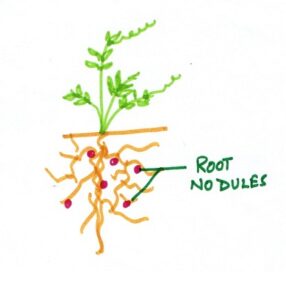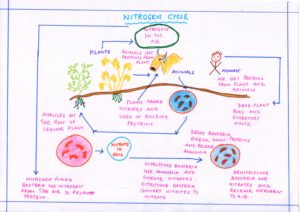USES OF MICROORGANISMS
INTRODUCTION: Bacteria are friends as well as foes of man. They play an important role in industry, agriculture, medicine and in maintaining a clean environment. However ,many bacteria cause a number of diseases in human, animals and plants.
USEFUL ROLES IN AGRICULTURE:-
A) NITRIFICATION- The process of conversion of ammonia to nitrate is called nitrification. It is brought about by nitrifying bacteria in the soil on two steps.
*The soil bacteria, Nitrosomonas, convert ammonium ions (NH4+) into nitrites (NO2-)
*Nitrites are acted upon another bacterium Nitrobacter to form nitrates. These being soluble in water, are absorbed in plants through their roots.
B)NITROGEN FIXATION– The process of conversion of free nitrogen into nitrogen compounds is called nitrogen fixation. Free-living nitrogen-fixing bacteria like Azotoacter, Clostridium or symbiotic bacteria which live in the root nodules of leguminous plant
( Rhizobium) can fix free atmospheric nitrogen into nitrates.

C)DINITRIFICATION- The process of conversion of nitrates into nitrogen gas is called denitrification. It is carried out y free-living denitrifying bacteria such as Pseudomonas. These bacteria reduce nitrate ions of the soil into gaseous nitrogen which returns to the atmosphere. The cyclic pathway y which free nitrogen is circulated through the living and non-living components of the biosphere is called nitrogen cycle.

NITROGEN CYCLE
USEFUL ROLE IN INDUSTRY:-
A) PREPARATION OF CURD–Curd is prepared by the fermentation of milk by bacteria Lactoacillus. In this process, milk sugar (lactose) is converted into lactic acid. Sour taste of curd is due to lactic acid.
B) CURING OF CHEESE- Bacteria help in producing cheese of a particular taste.
C) CURING OF TEA–Bacteria add flavor to tea and coffee. Certain bacteria help in curing of tea. In curing, bacteria eat away the unwanted compounds, producing the characteristic flavor. Specific varieties of bacteria are used for this purpose.
D) TANNING OF LEATHER– The bacteria play a great role in tanning of leather. The raw leather is brittle and contains many fatty compounds. The raw skin that is to be tanned is immersed in water containing bacteria. Bacteria in this water eat away all the fatty compounds make the skin soft. Specific humidity and temperature are maintained for this purpose.
E) RETTING OF FIBRES – Separation of fibres from the plants like jute, hemp and flexis done by the pond water containing bacteria Clostridium butylecum. These fibres are used for making ropes, linens etc.
F) MANUFACTURE OF VINEGAR– Acetic acid id made from sugar solution due to the fermentation activity of specific bacteria Acetobacter aceti .
G) ALCOHOL AND ACETONES – Bacteria like Clostridium are used in the manufacture of alcohol and acetone from acetic acid.
USEFUL ROLE IN MEDICINE:-
Many bacteria are used for the production of vitamins, serum, antibiotics , vaccines etc.
A) PRODUCTION OF VITAMINS – Many bacteria live in the intestine of humans and synthesize certain vitamins such as vitamin B complex. Some bacteria live in the intestine of ruminants or herbivores animals and help in the digestion of cellulose by producing enzyme cellulose.
B) PRODUCTION OF MEDICINES OR ANTIBIOTICS – A chemical substance produced by microorganism which can prevent the growth other microorganisms is called antibiotic. Penicillin was the first antibiotic discovered in 1929 by Sir Alexander Fleming. The term ANTIOBIOTIC was first coined by Selman Waksman in 1942.
Penicillium notatum was the first mould from which penicillin was obtained. Commercially pencillin is being produced from Penicillium chrysogenum as well as synthetically.
Use of antibiotics- Antibiotics are used
- In medicine to fight diseases.
- As food preservatives to preserve meat and fish.
- In treating animal feed to prevent internal infection.
C)PRODUCTION OF SERUM – Serum is a clear yellowish fluid obtained after separating blood into its solid and liquid components after it has been allowed to clot. It contains antibodies. They are used to prevent specific bacterial infections and provide immunity in the body to particular diseases.
Preparation of serum – For preparing a serum , small doses of bacterial toxins are injected into the blood of a healthy animal such as horse. The toxin is injected at regular intervals with increasing concentration. The body of animal produces antitoxins to neutralize the effect of toxin. This continues for several months. The blood of such animal is then taken out clear straw coloured serum is separated out by clotting. The separated serum contains antitoxins and is stored at low temperature. Some examples of bacterial serum are *insulin from E coli .
*Blood coagulating factor VIII for treatment of Haemophilia A .
* Blood coagulation factor IX for treatment of Haemophilia B.
D)VACCINES- A vaccine is a preparation of live weakened germ used to produce active immunity against disease. It was first coined by Edward Jenner, for the process of administering live,weakened,microbes into the body for developing resistance to a particular disease. Here are some common vaccines obtained from bacteria:
| Name of the vaccine | Type of bacteria | Prevented diseases |
| TAB vaccine | Killed bacteria | Typhoid |
| BCG | Live and weakened
bacteria |
Tuberculosis |
USEFUL ROLE IN MAINTENANCE OF ENVIRONMENTAL BALANCE IN NATURE
Bacteria act as decomposer of the dead bodies of plants and animals and break them into simpler chemical compounds, such as nitrates,sulphates etc. Bacteria are scavengers of nature. They help to keep the environment clean and play an important role in the recycling of nutrients thereby increasing the soil fertility.
HARMFUL ACTIVITIES OF BACTERIA
CAUSING DISEASES: Bacteria cause many serious diseases in human, animals and plants.
| DISEASE NAME | AFFECTED ORGANISM |
| Tetanus
Tuberculosis Botulism |
Human being |
| Leaf spot
Soft root Vascular disease Bacterial galls |
Plant |
| Anthrax | Sheep |
| Black leg | cattle |
| Tuberculosis | Cattle |
| Cholera | Chicken |
| Pneumonia | Horse,sheep and
goats |
2)SPOILAGE OF FOOD BY BACTERIA
They spoil milk,meat,vegetables and other food items. Some bacteria release toxins into spoled food and cause food poisoning. Certain bacteria like Salmonella typhimurium and Clostridium botulinum cause severe type of food poisoning when food is contaminated by these bacteria is eaten. Clostridium botulinum causes food poisoning n canned or sealed foods commonly known as BOTULISM.
3) BIOWEAPON
Some pathogenic bacteria or toxins can be used as bioweapon to create bioterrorism. Bacillus anthracis is one such pathogenic bacterium which is found to be fatal to many mammals including human beings. It causes anthrax. Similarly bacteria causing cholera,botulism and poliomyelitis can alsobe used as bioweapons and can have devastating effects on human population and their food and water resources.
4)DINITRIFICATION
The denitrifying bacteria like Pseudomonas are found in soil. They metabolise inorganic nitrogen-containing compounds(NO3-) and reduce them to free nitrogen which escapes into the air. Therefore, these bacteria educe nitrogen content of the soil and reduce fertility.
CONCLUSION
Though bacteria have various harmful effects but still these can be our benefits if used wisely. Recently bacteria are used in solving energy crisis as well as reduction of pollution like–
** In big cities like delhi Mumbai and Kolkata, human excreta and sewage are collected in big reservoirs. These are decomposed by sewage bacteria . the gas produced in the process is collected and is supplied as a cooking gas. The solid part is used as manure in the field. So bacteria ultimately make our life easier in many ways.